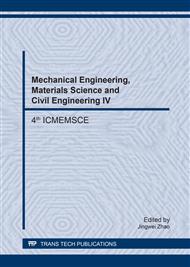[1]
Folinsbee, L.J. (1993) Human health effects of air pollution, Environmental Health Perspectives, 100. pp.45-56.
DOI: 10.1289/ehp.9310045
Google Scholar
[2]
Clayton, C.A., Perrit, R.L., Pellizzari, E.D., Thomas, K.W., Whitmore, R.W., Wallace, L.A., Ozkayna, H. and Spengler, J.D. (1993).
Google Scholar
[3]
Weschler CJ, Nazaroff WW. (2008), Semivolatile organic compounds in indoor environments. Atmos Environ., 42. pp.9018-9040.
DOI: 10.1016/j.atmosenv.2008.09.052
Google Scholar
[4]
Weschler CJ. (2009), Changes in indoor pollutants since the 1950s. Atmos. Environ., 43. pp.153-169.
DOI: 10.1016/j.atmosenv.2008.09.044
Google Scholar
[5]
Zhe Liu, Wei Ye, John C. Little. (2013), Predicting emissions of volatile and semevolatile organic compounds from building materials: A review. Building and Environment, 64. pp.7-25.
DOI: 10.1016/j.buildenv.2013.02.012
Google Scholar
[6]
M. Wensing, E. Uhde, T. Salthammer. (2005), Plastics additives in the indoor environment-flame retardants and plasticzers; Science of the Total Environment, 339. pp.19-40.
DOI: 10.1016/j.scitotenv.2004.10.028
Google Scholar
[7]
Bonvallot, N., Mandin, C., Mercier, F., Le Bot, B., Glorennec, P. (2010) Health ranking of ingested semi-volatile organic compounds in house dust, Indoor Air, 20. pp.458-472.
DOI: 10.1111/j.1600-0668.2010.00667.x
Google Scholar
[8]
Bornehag, C., Sundell, J., Weschler, C. J. (2004), The Association between Asthma and Allergic Symptoms in Children and Phtalates in House Dust: A Nested Case-Control Study, Environmental Health Perspectives, 112. pp.1393-1397.
DOI: 10.1289/ehp.7187
Google Scholar
[9]
Bergh, C., Torgrip, R., Emenius, G., Ostman, C. (2010), Organophosphate and phthalate esters in air and settled dust – a multi-location indoor study-, Indoor Air, 21. pp.67-76.
DOI: 10.1111/j.1600-0668.2010.00684.x
Google Scholar
[10]
Abb, M., Heinrich, T., Sorkau, E., Lorenz W. (2009), Phthalates in house dust, Environment International, 35. pp.965-970.
DOI: 10.1016/j.envint.2009.04.007
Google Scholar
[11]
Larsson, M., Hagerhed-Engman, L., Kolarik, B., James, P., Lundin, F., Janson, S., Sundell, J., Bornehag, C. G. (2010) PVC-as flooring material- and its association with incident asthma in a Swedish child cohort study, Indoor Air, 20, pp.494-501.
DOI: 10.1111/j.1600-0668.2010.00671.x
Google Scholar
[12]
Hyun-tae. Kim, Shin-ichi. Tanabe, Kotaro Okada. (2010), Measurement of DEHP concentration in house in Japan and Korea. Architectural Institute of Japan, Environmental Engineering 2, 75. pp.713-720.
DOI: 10.3130/aije.75.713
Google Scholar
[13]
NTP-CERHR (2006) Monograph on the Potential Human Reproductive and Developmental Effects of Di (2-Ethylhexyl) phthalate (DEHP), U.S.A.: http: /ntp. niehs. nih. gov/ntp/ohat/phthalates/dehp/DEHP-Monograph. pdf. [Assessed12 July 2013].
DOI: 10.1016/j.reprotox.2006.04.007
Google Scholar
[14]
Fromme, H., Gruber, L., Seckin, E., Raab, U., Zimmermann, S., Kiranoglu, M., Schlummer, M., Schwegler, U., Smolic, S., Volkel, W and for the HBMnet (2011).
DOI: 10.1016/j.envint.2011.02.008
Google Scholar
[15]
Koch, HM., Drexler, H., Angerer, J. (2004), Internal exposure of nursery-school children and their parents and teachers to di(2-ethylhexyl) phthalate (DEHP), Int J Hyg Environ Health, Vol. 207, pp.15-22.
DOI: 10.1078/1438-4639-00270
Google Scholar
[16]
Koch, HM., Drexler, H., Angerer, J. (2002), An estimation of the daily intake of di(2-ethylhexyl) phthalate (DEHP) and other phthalates in the general population, Int J Hyg Environ Health Vol. 206. pp.77-83.
DOI: 10.1078/1438-4639-00205
Google Scholar
[17]
Latini, G., Wittassek, M., Vecchio, AD., Presta, G. (2009), Lactational exposure to phthalates in Southern Italy. Environmental International, Vol. 35. pp.236-239.
DOI: 10.1016/j.envint.2008.06.002
Google Scholar


